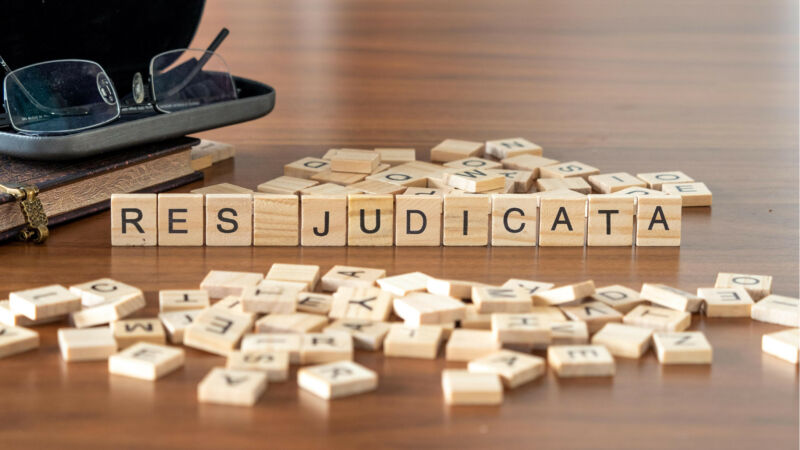In order to prevent needless waste of judicial time and energy, it is critical to ensure litigants do not overburden courts with redundant and duplicative proceedings. There are several legal doctrines aimed at that important preservation, most notably, “res judicata.”
The doctrine, which derives from the Latin of “a matter judged,” is designed to prohibit parties from relitigating a claim or a defense of something that has already been decided. The idea is meant to ensure the finality of judgments and conserve judicial resources. Additionally, the repeated litigation of an already adjudicated matter is generally not in the public’s best interest.
Conventional wisdom says one judicial contest should be enough for litigants to make their claims or mount a defense. This is critical as the amount of judicial work has increased in recent years.
What are the three elements of res judicata?
Res judicata has three general elements: re-litigation, same cause of action, and same or closely related parties.
Re-litigation
Res judicata prevents a party from bringing a claim once that particular claim has been subjected to a final judgment in some previous lawsuit. Re-litigation applies to a new lawsuit brought in any court, not just the one responsible for earlier judgment. This piece of res judicata is considered the most straightforward of the doctrine.
Same cause of action
Similarly, res judicata prevents a party from bringing the same claim or cause of action against the defendant once a final judgment has been made. The term ‘claim’ is the legal demand for compensation, while ’cause of action’ is the set of elements that allow for legal remedy.
Same or closely related parties
If the parties to a lawsuit are individuals, it is inherently easier to identify if a new lawsuit does, in fact, involve those individuals. However, the principle of res judicata can also prohibit litigation brought by parties or entities “in privity” to the party involved with the original lawsuit. This can include anyone “acting as an agent” on behalf of the original plaintiff, or any subsidiary of, for example, a corporate plaintiff. And the same principle applies for defendants.
Res judicata vs. collateral estoppel
The broader doctrine can be further divvied into two separate, major components: the first is res judicata, or “claim preclusion,” and the second is “collateral estoppel,” which is also known as issue preclusion.
Res judicata prohibits a second action on previously litigated matters as a whole and cause of actions/claims spawning from similar subject matter.
Alternatively, collateral estoppel prevents additional litigation of “particular issues” within previously resolved in prior cases. In practice, collateral estoppel is the principal concept behind double jeopardy protections for criminal defendants. As established in Benton v. Maryland, this protection is binding in both state and federal courts by the Due Process Clause of the Fourteenth Amendment.
In order to invoke the collateral estoppel, parties must establish several elements:
- First, the facts in question were fairly and fully litigated.
- The facts were essential to the first action’s judgment.
- The parties were deemed adversarial with respect to that action.
What is an example of res judicata?
Res judicata has broad practical applications. Recently, its use was tested in the 2018 patent lawsuit, Sowinski v. California Air Resources Board, which affirmed res judicata applied not only to cases resolved on the merits —the facts and evidence of a case—but also ones adjudicated on procedural grounds.
The first lawsuit occurred in 2015, when Richard Sowinski, inventor of an electronic method for claiming pollution tax credits, sued the California Air Resources Board (CARB) over their alleged use of his patent in one of their programs. The court dismissed the complaint because Sowinski failed to respond to motions before the deadline.
Sowinski filed a lawsuit again in 2018, this time seeking infringement damages from the 2015 case decision. He argued that res judicata should not apply since a prior suit was, in fact, resolved on procedural grounds, rather than the merits of the purported infringement. However, the U.S. Court of Appeals for the Federal Circuit affirmed the lower court ruling applying res judicata anyway, since the cases were essentially the same.
What attorneys need to know about res judicata in court
Generally, the value of res judicata lies in its preservation of time and resources. It is also, logically, a very intuitive piece of law. The burdens to the court are obvious when you remove important protections against waste and frivolity.
“If at first you don’t succeed, try again” is a fine concept for little leaguers and struggling artists; however, it doesn’t work quite so well with respect to attorneys, judges, plaintiffs, and defendants. For these reasons, we see great application of the doctrine in our judicial system.
For more information about how to apply (and counteract) relevant, emerging legal doctrines like res judicata, see our coverage of the increasingly applied “Reptile Theory.”









